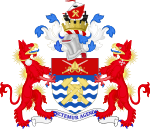Rugby Road Halt railway station
Buildings and structures in ChiswickDisused railway stations in the London Borough of HounslowFormer North and South Western Junction Railway stationsLondon railway station stubsRailway stations in Great Britain closed in 1917 ... and 2 more
Railway stations in Great Britain opened in 1909Use British English from January 2018

Rugby Road Halt was a short lived railway station in London on the Hammersmith & Chiswick branch line from South Acton to Hammersmith & Chiswick. The station was opened by the North & South Western Junction Railway in 1909 as an attempt to gain passenger numbers since the opening of the District Line. It consisted of a short wooden platform long enough for one coach. The station closed in 1917.
Excerpt from the Wikipedia article Rugby Road Halt railway station (License: CC BY-SA 3.0, Authors, Images).Rugby Road Halt railway station
Saltcoats Road, London Acton (London Borough of Ealing)
Geographical coordinates (GPS) Address Nearby Places Show on map
Geographical coordinates (GPS)
| Latitude | Longitude |
|---|---|
| N 51.5033 ° | E -0.2567 ° |
Address
Saltcoats Road
W4 1AR London, Acton (London Borough of Ealing)
England, United Kingdom
Open on Google Maps








